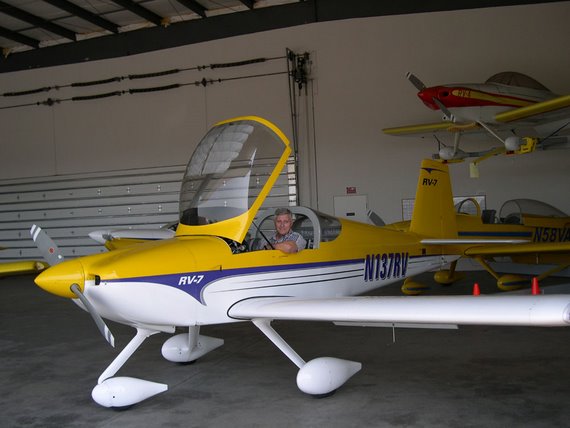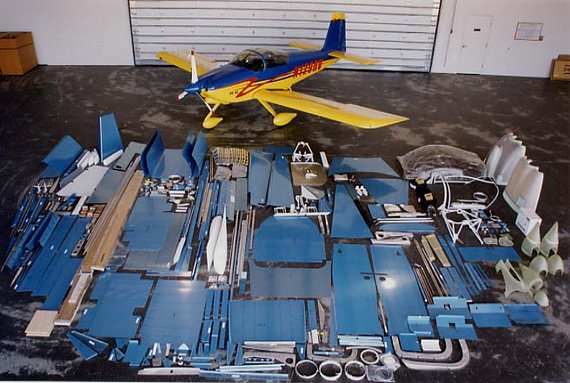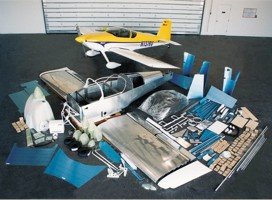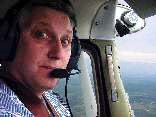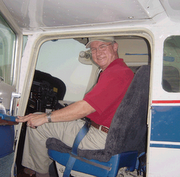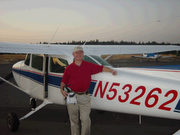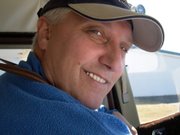Introduction - N9XG
We're building an RV9A together. The tail number is already reserved and is "N9XG"
It's the biggest project either of us has ever started. We're having a lot of fun and learning many things about airplane construction and about ourselves as well. This site is about the process, and our progress.
We will be updating this from time to time with progress reports. If you can't see enough detail in any of the pictures you can click on them and they will expand (like Magic).

We finished all the fitting, drilling, de-burring and now the two seat backs are ready to prime and rivet. Decided not to prime them (yet).
Having finished the preparation of the crotch strap attachment, we decided to hold off riveting them in until we've connected up the controls; just to make it a little easier.
We now move on to assembling the seat backs. We've prepared all the parts and so now we mark and pre-drill the holes for riveting. We decided to pre-drill at 3/32" even though they will end up at 1/8". Photos will be posted soon.
Had hoped to work ahead, but this weekend Dad broke his hip and is in the hospital.

Last night with the help of two friends, we got both steps ready to attach. Although we've been told it was unnecessary to add a doubler on the inside, we did it anyway. And it makes me feel better. After they left me, I tidied up the doubler plates and de-burred all the holes.
We probably won't attach for awhile just to avoid running into them with an unguarded shin. Besides, I want to get them all nicely primed and painted before they get riveted on. I plan to do some cosmetic grinding and removal of any rough edges.
Below is an inside view of the port side step.

I also learned of a company in Florida that makes engine cowls, plenums an wheel pants that promise to add speed to the plane. The plenum promises to keep all four cylinders cooled uniformly. The company is named James Aircraft and here is
a link to their websiteEarlier in the week, I ordered the attachment for the restraint system from Vans. It gets installed between the ribs under your seat.

All my life I've been told that I needed to use more restraint, I went and bought some for the plane. Got two units on ebay for just under $100 total.
Last night I cleaned out all the aluminium dust and misc debris from the fuselage. Then we riveted down the seat and the pitch servo attach bracket. We also test fitted the control levers and connecting rods. It make it more fun when you make airplane sounds if you can do a hard bank...
We seem to be making progress each build night, and that is great. Now my challenge is to line out the work for the next session and try to have things ready to roll when help arrives.
Last night Master-Chief Bob and I located and drilled the bracket that will hold the pitch servo for the autopilot. It was good to have someone holding back pressure on the piece while I was drilling.
We also clamped and drilled the angle that holds the seat back. Next time we will be able to do some riveting.

Since our engine will be fuel injected, I called and ordered the Andair boost pump and filter assembly. Also bought a fuel selector valve while I was in the business.
They arrived and are elegant in their simplicity.
We drove from Federal Way to Kamloops BC on Aug 21st arriving 07:30 at the Aerosport facility on the airport. It was a 6 hour drive. We spent about 4 hours of Bart's time getting all our questions answered. At the end we ordered a new IO320 160 hp fuel injected engine with a hybrid ignition system; one slik mag and one electronic ignition. That means we will have aviation plugs on the bottom and automotive plugs on the top. We both were glad that we made the trip as we wanted to fully understand what and why we chose what we did. Since we are not ready for the engine we asked for a December delivery date. Can't wait to see it under the tree...
No good decision will go unchallenged! Don't believe me? Try it! There seems to always be something waiting in the wings to become a crisis or a distraction. Never the less we continue moving forward.
Yesterday we made progress on the electronic flap housing. I am working with two retired Navy chief petty officers; one senior and the other master. The dynamic is really good. The master has much more experience than the two of us combined. So he is able to keep us moving forward when the tendency in the past has been to stop for prolonged periods of cogitation and hand wringing when something is unclear. His credibility is more convincing than my 'gitter done' mentality too. Our master chief also has the wonderful ability to give input without dominating. We are very fortunate to have him helping us.
The plans call for a part to be fabricated from a piece of aluminum. The first was pretty good, so I made a second that was pretty bad. Then I purchased more angle, thinking I would make another closer to perfect. In reviewing the first one we decided that the first piece would do nicely and that I was being too hard on myself. It's hard to know when you're doing that if you've never built one before...
Our new Catto propeller arrived last week and boy is it pretty! Light too; only 30 pounds.

Now I need to find a place for it until it has an engine to hang on. I asked Craig about maintenance and he indicates that it's pretty much maintenance free. Regarding storage; he suggested laying it flat rather than letting it sit on the wingtips. Here's a picture from the Catto website that shows how it's built.

I am planning to go to Kamloops B.C. this week to chat with Bart at Aerosport about an engine. Should be a real education as I know almost nothing about engines.
As you can see, the last post was three months ago. That's about how long it's been since any real work was done on the plane. What happened was this; we ripped out our fireplace and chimney which had been a visual barrier between the kitchen and the lake. After they were removed, we installed a skylite, a new island and cooktop, and tiled the kitchen. Oh, we also added five feet of glass to the view of the lake. Here's are a couple of after shots. Until one lives thru a remodel and all the associated mess, you can't appreciate it.


So anyway, the remodel is done with only minor things to finish. My wife is happy and everyone that sees it is impressed. I still find myself stopping just to appreciate the beauty.
Now about the plane; You can imagine the state of the shop after 2+ months of remodelling. Every tool out, nothing put away, just one heck of a mess. So a couple days of cleaning and putting things away and now we can find the wings and the fuselage again.
We have found a local fellow with more experience than us who also has the time to spend with us. His name is Bob and we are hopeful that we can get some momentum back and get this project rolling again. Stay tuned!

Tonight we mounted the flaps and ailerons to see how they fit together and that the alignment is good. It is! We were both very pleased with the fit.
Bob set the length of the aileron push rod and I assembled the connecting hardware.
Here you can see the bell crank in the left wing and how it connects to the main push rod and the aileron push rod.


It always feels good to be able to say "That's done". Well the gap fairing is done. We used just about every type of rivet doing it. Sollid rivets were called for, but with the quickbuild wings it was difficult to buck them in some places. So we started using cherry max rivets. They work great especially if you get the right length. If you use the wrong length you get experience at drilling out rivets that like to spin... argh. Then we decided that since the gap fairing isn't really structural, we didn't need to use the expensive structural pull thru rivets; instead we used the LP4-3 cheapie pull thru rivets. In the picture above you can see a solid rivet on the right and two cherry max rivets to the right.
After we finished with the fairing we moved on to installing the Tru Trak servo in the right wing. Here's a picture. You can click on it if you want to see a bigger image.

We left most of the connections loose because we are not sure that they are correct. The directions are not very clear. So we will be calling the fine folks at Tru Trak to ask some questions. We also fiddled around with fitting the right aileron. We are thinking we want to get it painted before we commit to installing. All the little washers and spacers are difficult to install and we would like to not do too many iterations of putting it on and taking it off.
Had a little time this afternoon so I went out and cut the four pieces of angle that the rudder pedals are attached too. I think the part number is f6117c, but I'm working from memory here. These were super easy pieces to make; just cut four pieces 4 pieces long. I probably spent an hour doing that and polishing up the welded end on my new aileron push rods(Thanks Doug Drees).
I ordered cherry max rivets from Pearson's on Friday. They should be in Monday, so I can install them. Unfortunately they are not cheap.

Tonight we primed the gap fairings and started installing. Mostly went fine, but there are several pesky holes that will need special attention. Also need to talk to Vans about our use of pull thru rivets where bucking would be really tough.

We also mounted the left aileron to see how it fits. I think it fits great.
So last night we finished match drilling, deburring, and dimpling of the fairings and the skin on one wing. Dimpling the remaining wing will go quick and easy with the pneumatic squeezer.
Since the wings are quickbuilts there's no way to buck some of the rivets. For that reason we are thinking pull thru rivets. Need to check with Vans to see if they are structural or not. Plans call out a solid 1/8 inch rivet (AN470AD...) so we may need to use Cherry Max. Cherry Max are actually easy to use; but expensive.
Oh, we also measured and cut the aileron push rods (again). This time I'm pretty sure the lengths are correct. Vans makes you conjure the length to cut rather than just calling it out for you. I don't know why, but instead of treating it like the other push rods you have to cut, the length they give you is from the center of the end rod bearing to the center of the other end rod bearing. That removes all doubt as to what the finished length needs to be, but leaves you to measure the parts and calculate how long the steel tube needs to be.

Tonight we cleaned the gap fairings and then match drilled them. Most of the time was spent cleaning and deburring the parts. The fairings are made of thin aluminum and so we had to be careful to avoid bending them.
In this picture you can see them all clecoed into place.
The match drilling entailed two different size holes; 3/32 and 1/8th inch. I had forgotten how much fun it is to work with clecoes.


Last night we were fortunate that Paul came by with his Cleveland squeezer. The pneumatic squeezer couldn't get in to do a straight pull. It's called the 'Main Squeeze' and can use the yokes I have for my pneumatic squeezer. Anyway, we finished attaching the aileron attach brackets. (it's about time)
The new shop lights are so bright that the can lights now look kinda puny.
We did some brainstorming about the wingtips and the lights they'll contain. I think we have a pretty good plan for how it will go together.
Started cleaning the shop and putting things away. So much so, that after a while I had room on the bench to work on parts. It sure is nice to have a clean place to work.
So I started fabricating some of the parts for behind the panel. I know I'm working out of sequence, but I figure if I keep moving ahead the effort will have a cumulative affect of getting finished. I would like to be ready for the engine this summer. That means I have to keep making progress and not screw up too many parts along the way. This business of buying extra parts gets old real fast. It's not like this is a cheap project to begin with.
After I got clarity on the aileron bell cranks and got them installed, it occurred to me that I had not installed the servo for the auto pilot. So I will need to back up and get it right. Gee this is humbling stuff. I read so many builder sites and they strike me as some kinda brilliant. Oh well, we just keep building...
The Process
Most of us think of the airframe as the main thing, and I suppose it is; since you can't fly without it. The kits that Vans sells are match hole punched. That means that the holes are already located and punched when you get them. This saves a lot of time as you can imagine. So what follows is what you do once you've unpacked and inventoried the parts from the factory.
There are several thousands of these planes flying. Rather than making mistakes first-hand, I recommend looking at the web sites of builders who have already done this. Some of my favorite links are provided. You should also look at Van's 'Links' page for the model you're building.
Before touching the parts, it is advisable to read the instructions and review the drawings until you have a clear idea what needs to happen and what sequence it needs to happen in. The drawings are invaluable.
Each sub assembly requires the same basic process:
1. Prepare the parts for fitting. This entails cleaning, filing, and finally scotchbrighting. In addition, some parts require fabrication and/or machining.
2. Fitting is done numerous times. The pre-punched holes are matched to the corresponding part(s) and are held together with clecos.
3. Match drilling is done in assembly to provide optimum fit.
4. Once the holes are match drilled to the proper sizes, the part is disassembled and deburred to remove any sharp edges and irregularities that might result in a poor fit or the development of a crack.
5. Rivets that will be flush with the skin require either a dimple or countersinking. This is normally obvious, but sometimes the rivet needs to be flush and it's not clear at first glance just why.
6. At this point, a coat of primer and (in some cases) paint is applied protect the metal from corrosion. We've decided to prime and paint all skeletal parts; i.e. Spars, Ribs, etc. Skins will be primed where they connect. The method to our madness is this; we want defects to appear first in the skin where they are easiest to fix and pose less of a threat.
7. This is a dangerous part of the process because you might want to rivet something. But WAIT! Review the plans and the directions again.
8. Okay, so you've reviewed the plans and the parts are ready to assemble. Double and triple check the plans to ensure that the proper rivets are used. It's easy to mess this up or get out of sequence.
Rivets and Riveting
There are thousands of rivets that hold the plane together. Since this is an important task, let's talk a bit about them.
The rivets we'll be using are made of aluminium and are set in one of several ways; Hammering, Squeezing, Pull through.
Hammering a rivet is best done with a partner. One person operates the rivet gun and the other holds a bucking bar on the back side to create a shop head. I've tried doing this alone and almost always with undesirable results. The idea is for the shop head to be approx 1.5 times the diameter of the shank of the rivet.
Squeezing a rivet requires a special tool and is my preferred way whenever possible. Some folks use a manual squeezer, but I like pneumatic squeezer. They develop approx 3,000 pounds of force in the last 1/8th inch of the piston's travel. So proper adjustment is important. Once adjusted properly it will deliver consistent rivet sets.
Pull through (aka Blind or Pop) rivets are for those applications where there is no way to get access to the back side of the rivet. In general this type of rivet has inferior strength characteristics compared to a solid rivet. The noteworthy exception is the Cherry Max rivet. It is a pull through rivet, but it is also structurally rated and not cheap.
Removal
When rivets are set badly (as is sometimes the case) You need to decide if it's so bad that it just has to be replaced or is it okay as is. The main concern is to remove the offending rivet without doing damage to the hole it's in; e.g. enlarging or elongating or both.
If it just doesn't pass muster, get a drill bit about the diameter of the rivet shaft or smaller. Center punch the head of the rivet (solid rivets only) and then carefully drill thru the head just down to where the shaft meets the hole. Once this is done, insert and old drill bit into the hole and wiggle the head until it snaps off. Once the head is off you should be able to push it out with a punch.
With pull through rivets this can be problematic, as the shaft is most likely steel and may turn with the drill bit. Another problem with removing blind rivets is this. Blind rivets are used because access to the back side is either difficult or impossible. Onc you commit to removing the blind rivet, you have to figure out how to remove the back side when you punch it thru the hole.


 Last night with the help of two friends, we got both steps ready to attach. Although we've been told it was unnecessary to add a doubler on the inside, we did it anyway. And it makes me feel better. After they left me, I tidied up the doubler plates and de-burred all the holes.
Last night with the help of two friends, we got both steps ready to attach. Although we've been told it was unnecessary to add a doubler on the inside, we did it anyway. And it makes me feel better. After they left me, I tidied up the doubler plates and de-burred all the holes.


 Now I need to find a place for it until it has an engine to hang on. I asked Craig about maintenance and he indicates that it's pretty much maintenance free. Regarding storage; he suggested laying it flat rather than letting it sit on the wingtips. Here's a picture from the Catto website that shows how it's built.
Now I need to find a place for it until it has an engine to hang on. I asked Craig about maintenance and he indicates that it's pretty much maintenance free. Regarding storage; he suggested laying it flat rather than letting it sit on the wingtips. Here's a picture from the Catto website that shows how it's built.





 We left most of the connections loose because we are not sure that they are correct. The directions are not very clear. So we will be calling the fine folks at Tru Trak to ask some questions. We also fiddled around with fitting the right aileron. We are thinking we want to get it painted before we commit to installing. All the little washers and spacers are difficult to install and we would like to not do too many iterations of putting it on and taking it off.
We left most of the connections loose because we are not sure that they are correct. The directions are not very clear. So we will be calling the fine folks at Tru Trak to ask some questions. We also fiddled around with fitting the right aileron. We are thinking we want to get it painted before we commit to installing. All the little washers and spacers are difficult to install and we would like to not do too many iterations of putting it on and taking it off.


 Tonight we cleaned the gap fairings and then match drilled them. Most of the time was spent cleaning and deburring the parts. The fairings are made of thin aluminum and so we had to be careful to avoid bending them.
Tonight we cleaned the gap fairings and then match drilled them. Most of the time was spent cleaning and deburring the parts. The fairings are made of thin aluminum and so we had to be careful to avoid bending them. 

